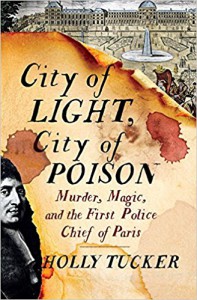City of Light, City of Poison by Holly Tucker

This true account of a massive criminal investigation in 1670’s Paris could have been much better. In brief, many people accused others of involvement in poison and witchcraft, and at least some of the poisoning seems to have been true (various poisons were in fact found in the possession of some of these folks, and in the case of one noblewoman, her father and brothers all really did die under similar and suspicious circumstances). Louis XIV appointed Nicolas de la Reynie police chief to reduce the high crime rate in Paris at the time (including lots of murders), but made him back off this particular investigation once fingers began to be pointed at some of Louis’s own mistresses.
It’s interesting stuff, and a quick read; you could likely read it in a single sitting if so inclined. That said, Tucker takes a somewhat novelistic, almost sensationalist approach, despite the fact that she does seem to stick to documented historical facts. There are many chapters about the doings of Louis’s mistresses and female associates (including the sudden death of his sister-in-law Henrietta Anne, sister of Charles II of England), which never really merge with the poison storyline. At best the history of the mistresses provides some background on why one or two of them might have been as cutthroat as was alleged (though only sort of; on their way out these women got significant parting gifts from the king), but it’s all indirect and spends a lot of time with mistresses who were never even implicated. After all the talk about Henrietta Anne I thought we’d get at least a theory on who might have poisoned her, but the author offers very little analysis in the end.
Because the author doesn’t really analyze the facts presented, it’s a bit hard to tell, but I had the impression she was more on the side of the authorities – and more inclined to believe the confessions of people who had been imprisoned for months or sometimes even years without trial, but with the ever-present threat of torture and execution – than I was. Judicial torture was a commonplace part of the process, though strangely, it occurred between sentencing and execution. (I don’t know if the examples the author presents are representative, but in the book, only one person provided meaningful new information under torture, and she later recanted.) The torture is described in unpleasant detail and recurs frequently throughout the book. Noblewomen fared far better in court than commoners, some of whom seem to have been convicted and executed before their cases were fully investigated. There’s a witch hunt quality to the whole thing in the figurative as well as literal sense, and by the time Marie-Anne Mancini told off the police chief in court I was cheering her on. Oddly there’s no discussion of the gender dynamics at play here either – given that most of the accused appear to have been women, that abortion was a major accusation and that a common motivation for women accused of poisoning seems to have been domestic abuse and/or escaping forced marriage.
At any rate, colorful history but not very substantive. The author certainly has storytelling skills, but the book is lightweight.





